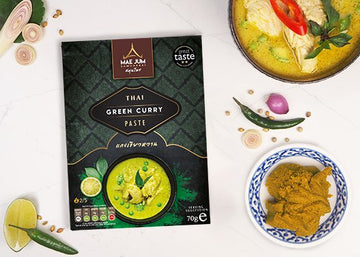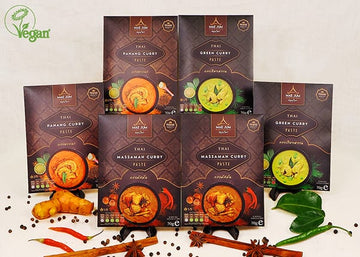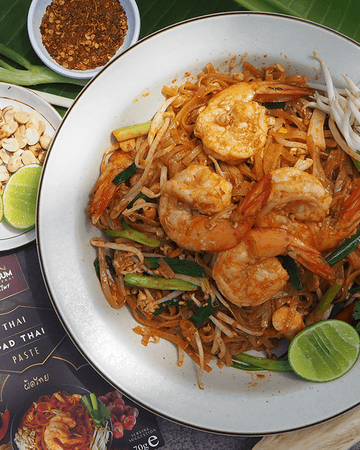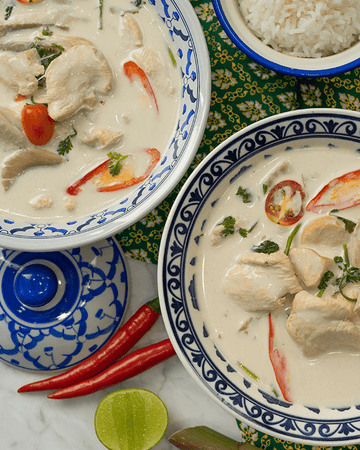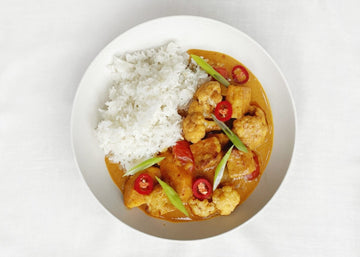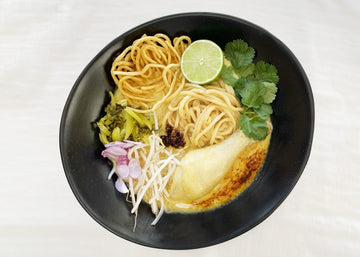Delicious Vegan Thai Panang Curry with Tofu and Vegetables: A Simple and Flavourful Dish
Thai cuisine is renowned for its rich and vibrant flavours, combining sweet, salty, sour, and spicy elements into perfectly balanced dishes. One of the best examples of this balance is Thai Panang curry, a mildly spicy and slightly sweet curry that’s deeply aromatic and satisfying. The addition of tofu and vegetables like mixed peppers and mangetout makes it a healthy, filling, and totally vegan option that’s easy to prepare. Whether you're a seasoned vegan or just looking for a delicious meat-free meal, this Tofu Thai Panang Curry is the perfect recipe for you.
What is Panang Curry?
Panang curry is a popular type of Thai curry that has its origins in central Thailand. Unlike Thai red or green curry, Panang is slightly less spicy, offering a milder, sweeter flavour profile, which makes it a favourite for those who prefer something rich and fragrant without overwhelming heat.
What distinguishes Panang curry from other types of Thai curries is its thickness and richness. It typically contains ground peanuts or a peanut-based element, which gives the curry a creamy texture and a nutty undertone. The blend of spices in Mae Jum’s Panang Curry Paste includes ingredients like galangal, lemongrass, chilli, and kaffir lime leaves, which lend the curry its signature citrusy, earthy aroma.
Why Tofu is a Great Protein for Curry
Tofu is the perfect addition to this curry because of its versatility and ability to absorb flavours. When fried until golden and then simmered in the rich Panang curry sauce, the tofu soaks up the aromatic flavours, creating a delicious, meat-free protein alternative. The extra-firm tofu used in this recipe holds its shape well, providing a chewy texture that contrasts beautifully with the soft, creamy curry.
For those who may not be familiar with tofu, it’s a soy-based product that’s rich in protein and an excellent substitute for meat in a variety of dishes. It’s naturally gluten-free, low in calories, and cholesterol-free, making it a great addition to any diet, particularly for vegans and vegetarians. When prepared correctly, tofu becomes a flavourful and satisfying ingredient that complements the rich and aromatic Panang curry sauce.
The Sweetness of Mixed Peppers
One of the key elements of this dish is the use of mixed peppers, especially red peppers, which bring a natural sweetness to the curry. Red peppers are sweeter than their green counterparts and are perfect for balancing the slight spiciness of the curry paste. Their bright colour also adds vibrancy to the dish, making it visually appealing as well as delicious.
In this recipe, the peppers are added midway through the cooking process, ensuring that they remain slightly crunchy, adding a textural contrast to the softness of the tofu and the richness of the curry sauce.

Why You’ll Love the Addition of Mangetout
Mangetout, also known as snow peas, are thin and crisp peas that are often used in stir-fries and Asian dishes. In this Tofu Thai Panang Curry, they add a fresh, crunchy texture that complements the soft tofu and peppers. Their mild flavour works well with the coconut milk and curry paste, ensuring the dish remains light and refreshing.
In addition to their flavour and texture, mangetout is rich in nutrients like vitamin C and vitamin K, making this a healthy addition to the curry. Adding a handful of mangetout towards the end of the cooking process ensures they maintain their crunch while soaking up some of the delicious curry sauce.
Making a Creamy Curry with Coconut Milk
The creaminess of Panang curry comes from the generous use of coconut milk, which adds richness and a slight sweetness to the dish. Full-fat coconut milk is best for this recipe because it thickens the curry and provides the luxurious, creamy texture that Panang curry is known for. The coconut milk tempers the heat from the chilli and balances the savoury elements of the curry paste, creating a perfectly harmonious dish.
When cooking, it’s important to let the coconut milk simmer for a few minutes with the curry paste to allow the flavours to meld together. During this step, you’ll notice the oils from the curry paste rise to the surface of the coconut milk, which is a sign that the flavours are fully developing.
Kaffir Lime Leaves and Sweet Thai Basil: The Aromatic Touch
The final touch to this Thai Panang curry comes from kaffir lime leaves and sweet Thai basil. These two ingredients are essential for bringing the authentic flavour of Thailand into your kitchen.
- Kaffir lime leaves are intensely aromatic and provide a bright, citrusy flavour that complements the rich coconut milk and curry paste. In this recipe, the leaves are thinly sliced and added at the end to maintain their fresh flavour.
- Sweet Thai basil adds a mild, peppery flavour with a hint of anise. It’s used as a garnish at the end of the cooking process, bringing freshness and a burst of flavour to the dish.
Together, these ingredients elevate the dish, turning a simple curry into a fragrant and aromatic meal that’s bursting with authentic Thai flavours.
How to Make Tofu Thai Panang Curry: Step by Step
Ingredients:
- 2 tbsp coconut oil
- 35g Mae Jum Panang Curry Paste
- 2 tbsp light soy sauce
- 1 tbsp palm sugar
- 400ml coconut milk
- 300g extra firm tofu (cubed)
- 2 sweet peppers (roughly diced)
- 100g mangetout
- 3 kaffir lime leaves (thinly sliced)
- Handful of sweet Thai basil
Method:
- Prepare the tofu: Heat the coconut oil in a large saucepan over medium heat. Once the oil is hot, add the cubed tofu and fry until golden brown on all sides. Once done, remove the tofu and set it aside on kitchen tissue to absorb any excess oil.
- Fry the curry paste: In the same saucepan with the remaining oil, add the Panang curry paste and fry over medium heat for 2-3 minutes. This will help release the flavours and create a beautiful aroma.
- Add coconut milk: Pour in 100ml of coconut milk to loosen the curry paste and stir well. Add the soy sauce and palm sugar, blending the flavours together.
- Simmer the curry: Add the remaining coconut milk, diced sweet peppers, and simmer for 5 minutes, allowing the vegetables to soften slightly while the curry sauce thickens.
- Add mangetout and tofu: After 5 minutes, add the mangetout and, if needed, 100ml of water to thin out the curry. Stir in the fried tofu and allow everything to simmer for an additional 5 minutes.
- Finish with herbs: Turn off the heat and stir in the kaffir lime leaves and sweet Thai basil. This will bring a fresh, aromatic finish to the curry.
- Serve: Serve the curry hot with freshly made Thai Jasmine rice. The rice will soak up the delicious curry sauce, making each bite a flavourful and satisfying experience.
Why You’ll Love This Tofu Thai Panang Curry
This Tofu Thai Panang Curry is a delightful balance of sweet, savoury, and mildly spicy flavours. The combination of tofu, mixed peppers, and mangetout makes it both nutritious and filling, while the creamy coconut milk creates a rich, luxurious sauce that’s perfect for pairing with jasmine rice. Even if you’re not vegan, this dish is a great option for a light yet satisfying meal that doesn’t compromise on flavour.
Plus, it’s quick and easy to make, requiring minimal preparation and cooking time. In under 30 minutes, you can have a delicious, authentic Thai meal on the table that’s sure to impress both vegans and non-vegans alike.
Final Thought
Tofu Thai Panang Curry is the perfect dish for those looking to explore new flavours or add more plant-based meals into their diet. The mild sweetness of the Panang curry paste, paired with the richness of coconut milk and the freshness of sweet peppers and mangetout, creates a dish that’s both comforting and exciting. Whether you're cooking for yourself or entertaining guests, this curry is sure to be a crowd-pleaser.
